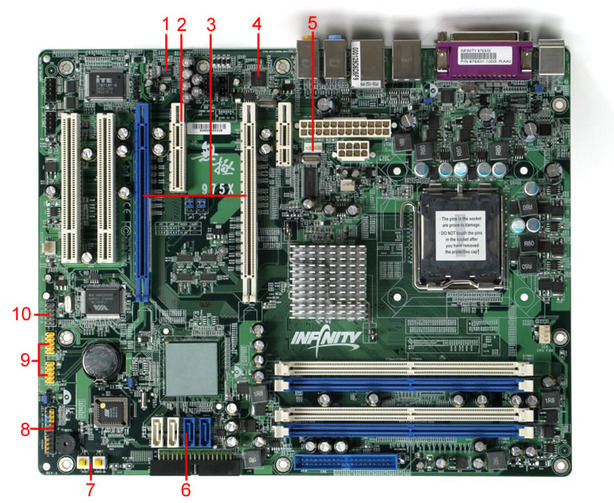Board layout:


There are four native SATA ports from the ICH7R offering all the common RAID modes up to RAID 5, but the only extra hard disk connector on the board is in the form of a single eSATA port courtesy of the JMB360 disk controller chip. On a less fulfilling motherboard, this is arguably quite sensible with all things considered. People looking at boards like DFI's Infinity 975X/G are unlikely to be running massive arrays of disk drives and if they were, we'd recommend looking at a dedicated disk controller anyway.
The two PCI-Express x16 slots support ATI's CrossFire technology and employs a digital switch to select the PCI-Express lane configuration. It chooses between either a single slot with the full 16 lanes or with both sharing the 16 lanes in an x8/x8 configuration. Using both of the x16 slots with dual slot coolers blocks one of the PCI slots, but the PCI-Express x4 slot is thankfully still usable.
The included x4 slot is also selectable but through jumpers: it will either run at x1 speeds when the other, top PCI-Express x1 is enabled, or, it will run at x4 speeds with the top PCI-Express x1 slot disabled. It's a shame the x4 slot isn't an open ended connector so it can take longer cards (like x8 or x16 for example). There's nothing stopping you taking a quick dremel to the end and easily shaving down the plastic in the slot.
Thankfully the board is passively cooled but DFI employ an interesting ceramic plate instead of a standard alunimium or copper heatsink on the southbridge which actually works better than you would expect. Ceramic is a more dense sustance than aluminium and has a greater heat capacity, meaning that the overall size of the heatsink can be smaller. The only issue we see with this is that the top of the southbridge heatsink is flat, meaning that there is much less surface area to radiate the heat from after it has been absorbed from the ICH7R chip.
Not surprisingly, the board comes with switches for power and reset on the PCB - it's certainly a cheap but effective way of keeping enthusiasts happy. However, the ATX power connectors could do with a little rearrangement. Being on the inside of the motherboard, routing the 24-pin ATX and 8-pin 12V power cables across the board and heatsink/fan unit is far from ideal.
In addition, that's actually a floppy power plug next to the two main power connectors - it's not a 4-pin fan plug. For those like me, who don't read the manual and assume they know better, this came as quite a shock and on closer inspection, it turns out that there is an identifying marking 'AUX POWER', but it's right inbetween the 24-pin ATX connector and the floppy connector itself. This isn't ideal, because it's not clearly marked.
It would have made more sense for DFI to use a standard 4-pin molex connector, as it would help to alleviate these potential problems. It's obvious that the additional power connector is there for improving the board's stability when using a pair of high end Radeons in CrossFire, but we think that it deserves some clearer markings on the board.
Aside from the power connector positioning, everything on the board seems reasonably well laid out. There is nothing about the layout that makes it breathtaking, but it's certainly not outstandingly poor, either.

MSI MPG Velox 100R Chassis Review
October 14 2021 | 15:04







Want to comment? Please log in.